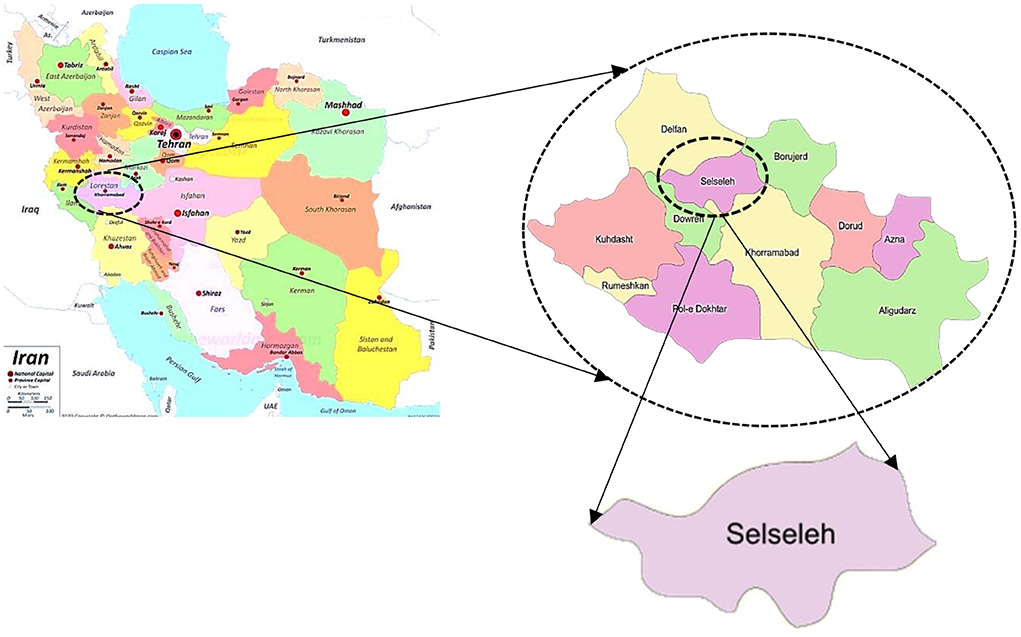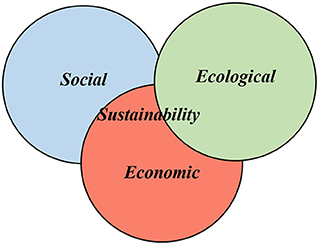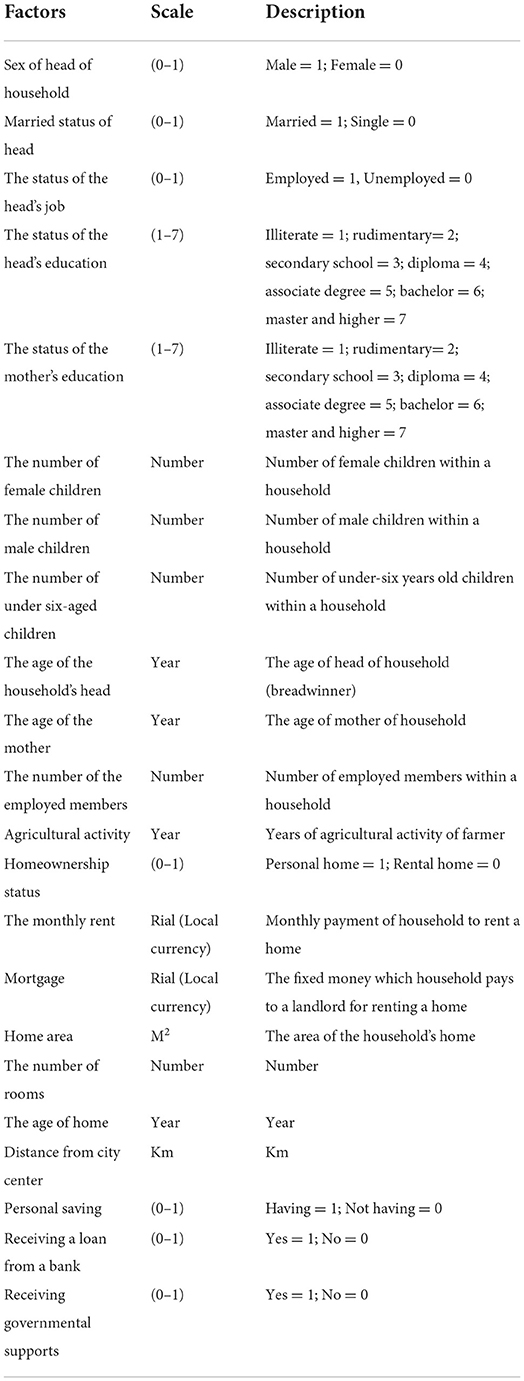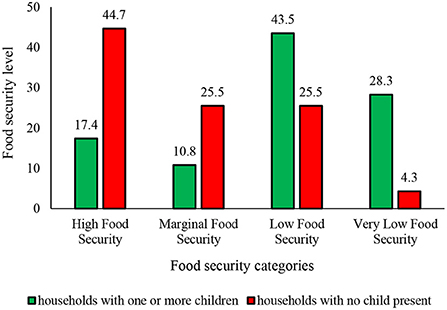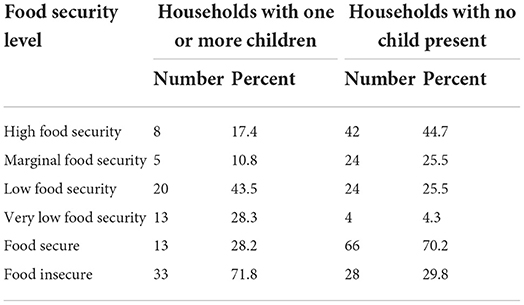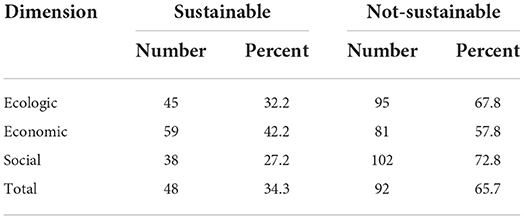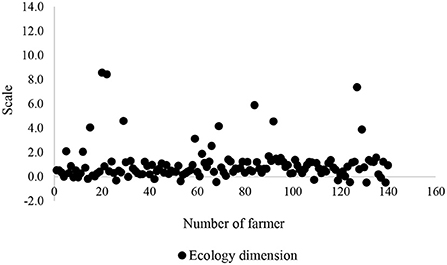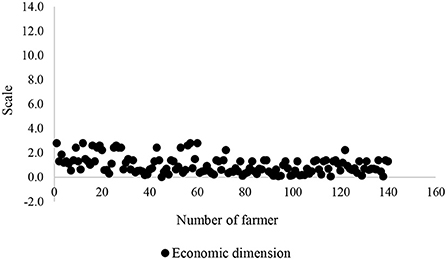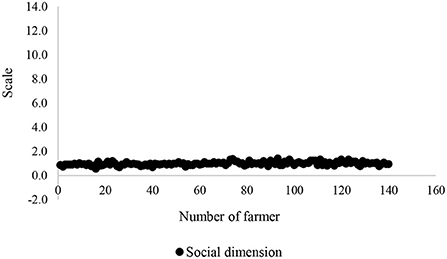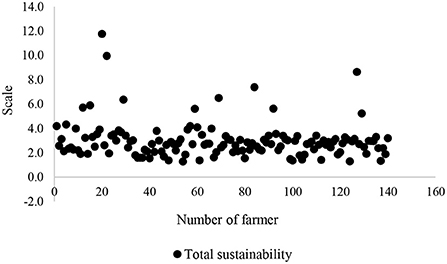- Department of Agricultural Economics and Rural Development, Lorestan University, Khorramabad, Iran
Due to the importance of sustainability in the world, we follow the missing pieces of the puzzle of sustainable agriculture and food security as a huge gap in the literature. To achieve this goal, a survey was analyzed to assess the linkage between these two concepts in the rural areas in Lorestan province in Iran. The status of food security was assessed using US Household Food Security Survey Module (HFSSM). A standard questionnaire extracted from the related literature was applied to calculate sustainability indicators. The results showed that the status of food security among households with no children (70%) was better than those with one or more children (28%). According to the Tobit model, none of the sustainability dimensions had a significant association with food insecurity. The results support the fact that the assessment of agricultural sustainability at the microeconomic level, short-term period, and a small, specified location cannot lead to reliable results due to the similar behaviors of farmers in these areas. The low level of agricultural sustainability is due to the lack of macroeconomic policies in the region to promote and disseminate the principles of sustainability, lack of plans and actions to promote sustainability by stakeholders and policymakers, ignorance of the target community, as subsistence producers who fall into a deprivation trap. The results suggest that policymakers should use two short-term and long-term strategies to improve the level of agricultural sustainability and increase food security status.
Introduction
The world's population is projected to reach 9.7 billion by 2050 (1), and as a result, by and large, food production is projected to increase by around 70% (2). In response, countries have already taken several collective initiatives to reduce the global food crisis, such as attention to the concept of food security (3, 4). According to the 1996 World Food Summit, “Food security exists when all people have physical and economic access at all times to adequate, safe and nutritious food that meets the nutritional needs and nutritional preferences for an active and healthy life”. High food insecurity and providing enough foods for all people has increased the work of policymakers and administrations globally to support more sustainable agriculture in the world (5). The first political operationalization at the United Nations Conference on the Environment and Development in 1992 was postulated: Everyone has the right to a decent life (11). The 2015 UN Agenda finally approached sustainable development based on ”ending needs“, such as poverty and hunger, and with the key phrases ”fulfilling human potentials in dignity and equality and in a healthy environment“ (6–8). The United Nations designed the SDGs targets as a collection of 17 interlinked global goals to be a ”blueprint for achieving a better and more sustainable future for all“. At the same time, feeding the more than 690 million hungry people today - and the other 2 billion people who will face hanger by 2050 - requires a profound change in the global food and agriculture system (9). Increasing agricultural productivity and sustainable food production is crucial to help reduce the risk of starvation. The two concepts of food security and sustainability have several features in common. They are broad and complex concepts used by various disciplines and non-governmental groups such as NGOs and governments, which often form their definitions (10, 11). Although all global institutions and policymakers emphasize sustainable agriculture as an appropriate instrument for providing the needed foods, an important question remains: Is there always a significant linkage between food security and sustainable agriculture? In other words, does sustainability lead to reducing food losses and enhancing food security status? We need a novel way to look at the linkage between these two inseparable concepts.
Few empirical studies in many countries have shown that sustainable agriculture is needed to improve food and nutrition security, and that the former can strengthen the latter. Chowdhury et al. (3) recommend any policy at the international, national, and local levels aimed at achieving food security should combine measures to address key global sustainability challenges (3). Skaf et al. (4) contend sustainable management of agricultural production provides access to healthy, wholesome, and nutritious food for the growing population (4). Another study suggests that sustainability should be considered as a part of the long-term time dimension in the assessment of food security (10). Another scientific group claims that the linkages between food sustainability and food and nutrition security intersect at global, national, local, and household levels (12). In fact, sustainable agriculture and sustainable food systems support food security (13). Nkomoki et al. (8) proved although the adoption of crop diversification and agroforestry as sustainability indicators is associated with higher household food security, other indicators, including intercropping and planting basins are not significantly associated with food security. Although theoretical studies emphasize that adhering to the principles of sustainable agriculture has a positive effect on food security, we face a dilemma: more production for food security and sustainable agricultural production. Some suggest that sustainable agriculture, at least in the short term and without appropriate support, may lead to a reduction in production, which in turn can reduce the motivation of farmers to implement sustainable practices.
As an important gap, none of these studies endeavored to demonstrate whether this nexus is always affordable in all areas or not. We think that a significant association between food security and sustainable agriculture is strongly linked to the geographical structure and farmers' behavior and varies region by region. The primary purpose of this paper is to find an appropriate answer to this puzzle with the inclusion of sustainability as an independent factor (in various models based on triple dimensions of sustainability) in defining and changing the position of food security. This article highlights the pros and cons of providing a deep and comprehensive understanding of the integration, links, and gaps between sustainable agriculture and food security in rural areas. Based on these explanations, the following hypotheses will be tested:
H1- More than half of farmers are food insecure in the study location.
H2- Most of the farmers are sustainable in the process of agricultural activity.
H3- Economic sustainability of farmers is positively associated with food security.
H4- The sustainable agriculture is positively and significantly associated with food security.
Materials and methods
Study area
The present study was carried out in Aleshtar city in Lorestan province as a province of the western Iran in the Zagros Mountains (Figure 1). This city is the center of Selseleh city in the north of Lorestan province. Information of Iran Statistics Center shows Aleshtar, with a population of 34,133 people in 2019, is ranked 238 among country's cities and ranked 8 among the cities of Lorestan province.
Study sample and data collection process
The data were collected using a questionnaire in the study location. We randomly selected 140 farmers using the Cochran formula. The questionnaire included two sections. The first section consists of a food security questionnaire based on the U.S Household Food Security Survey Module, and the second section consists of questions which were extracted from the literature to calculate and indicator of agricultural sustainability on that farm. Prior to collecting the data, the validity of all questions of the second section were assessed by a team of experts consisting of an agricultural economist, agricultural extension expert, psychology, environment, and social science experts, and three nutritionists. To reduce the possibility of error in completing the questionnaires, a pilot study was conducted on 20 rural households. Before collecting the data, the interviewers, recruited from students of agricultural economics, were trained in a 2-day workshop to ensure coordination and to reduce interpersonal variation in the data collection process. The questionnaires were filled out through face-to-face interviews with breadwinners (farmers).
Sustainability indicator
To calculate sustainable agricultural indicator, a questionnaire was used based on the literature (10, 14–19). For this aim, all items were categorized into three sub-categories, including economic, social, and ecological aspects (Figure 2) (7). All related items were extracted from the related papers in the field of sustainability, and some questions were added to the item collection based on the researchers' knowledge of the study area (Table 1).
As above-mentioned explanations, the validity of all questions was confirmed by an expert panel. The economic dimension of sustainable agriculture included ten items. All items of this criteria were alluded to all income and costs of farmers during the production process.
The social dimension consisted of 11 items to follow the farmers' knowledge and behavior, and their attitude toward sustainable agricultural activities. Finally, the ecological dimension which included 45 items was alluded to all interactions with agricultural activity, the environment, and environmental protections.
It was necessary to multiply each indicator by its weight before combining the indices. Other studies have used the principal component (PC) method to measure the weight of indicators in measuring stability (20–22). Hence, in the third step, the weight of each indicator was determined using this method. Then, the score for each indicator was multiplied by the identified weight. Next, the mean of sustainability was calculated in each dimension (Equations 1–3):
Where Eco1–Eco7 are scores given to 10 items of the economic indicator, and WEco 1–WEco 10: the weight of 10 items of the economic indicator in evaluation.
In which, Soc1–Soc11 are scores given to the social items of agricultural sustainability, and WSoc1–WSoc11 are the weight of the social items to calculate the social dimension of agricultural sustainability.
Where Ecol1 – Ecol45 are scores given to the ecological items to calculate the ecological dimension of agricultural sustainability, and WEcol1− WEcol45 are the weight of the ecological items. By summing up the mean of three dimensions together, the total sustainability (CI) value of SA was calculated in each area as:
Through Equation (6), the level of SA for each farmer is obtained. CI has also been used by other researchers (23).
Food security indicator
To assess food security status, the US Household Food Security Survey Module (HFSSM) was applied. The standard questionnaire in this method, which includes ten questions for adults and eight questions for children, is designed for a period of 1 year (12 months) or 1 month (with some modifications in questions 8, 12, and 14, and also in the number of occurrences) (24, 25) (Table 2). Using this approach, the household food security level is classified into four groups: high food security, marginal food security, low and very low food security. This status can be calculated for households with and without children. Also, this method can be used to assess the status of children's food security in three categories, including high or marginal food security, low and very low food security levels (25).
Based on the corrections made in recent years, the sum of positive answers to the questions asked in the HFSSM questionnaire is considered as the score of each household and is the basis of the final classification. The types of food safety classification for households with and without children are as follows:
1- For households with at least one child under 18 years
• Total positive responses = 0, high food security
• Total positive responses = 1–2, marginal food security
• Total positive responses = 3–7, low food security
• Total of positive responses = 8–18, food security is very low
2- For families without children
• Total positive responses = 0, high food security
• Total positive responses = 1–2, marginal food security
• Total positive responses = 3–5, low food security
• Total positive responses = 6–10, food security is very low
High and marginal food security status of households are classified as food secure households, and low and very low food security status are classified as food insecure households (25).
Quantitative model and variables description
The Tobit model is a regression model in which the observed variable range depends on some kind of censored levels. The term was invented by Arthur Goldberger, referring to James Tobin, who developed the model in 1958 to reduce the problem of zero inflation data to observe household spending on durable goods (26). The Tobit method can be easily extended to handle shortened samples and other non-randomly selected samples (27). The general form of the Tobit model is shown in the following relation (28):
In which, yi is an unobserved or latent variable, is an observed variable, γ′ is a vector (1*k) of parameters that should be estimated, zi is the vector of independent variables, ui is the standard error of the equation that is independent of explanatory variables and assumes a normal distribution with a mean of zero, and fix variance of σu (28). In the Tobit model of the present study, 0 was considered for the households with no food insecurity status, and the calculated indicator of food insecurity using HFSSM was assigned to households who faced several levels of food insecurity (11).
Generally, Tobit is a regression model used for data with a discrete and continuous part. In different regression models, the analysis data are either discrete or continuous, but in the Tobit model, there is a pattern of combining both types of data. In other words, Tobit can be considered as an extension of the probit method and an appropriate approach to dealing with censored data. The coefficients are calculated using the maximum log-likelihood function, which indicates the consistency of the model (27).
To assess the goal of the study, some independent factors were added to the Tobit regression based on the literature review (2, 9, 29–34). These factors are the characteristics of the head of the household, the status of properties, the financial status of the households, and the information of the household's members. All these factors are shown in Table 3.
Result
Assessing the food security status of the households showed that about 27% of those with one or more children are food secure (in high and marginal levels), while 73% of these households face various types of food insecurity including low and very low levels. On the other hand, 70% of the households with no child were food secure, while about 30% the households faced food insecurity (Figure 3).
According to the Table 4 the status of food security among households with no child was better than those with one or more children. The greater difference among households with and without children in terms of food security level is related to high and very low food security in the study location.
Assessing the status of food security of children revealed that about 65% of them faced low food security, while only 32% of these children were food secure in two categories, including high and marginal levels (Table 5).
Over half of the respondents (67.8%) were ecologically unsustainable, while about 32% of the total sample had ecological sustainability. Fifty-seven percentage of the farmers faced economic unsustainability, and 72% were socially unsustainable. Of the total sample, about 65% of the participated farmers faced total unsustainability. According to this result, most of the farmers were unsustainable in agricultural activity (Table 6).
The results of the sustainability status of the participating farmers in different categories of food security level are shown in Table 7. The high level of ecological and social sustainability is related to food secure group, while the highest level of the economic sustainability occurred in the food insecurity group with severe hunger. The score of the total sustainability indicator revealed the highest level was related to food secure and sever food insecure groups, respectively.

Table 7. The status of household's food security and agricultural sustainable dimensions in the study location.
Figure 4 demonstrates that the social dimension of sustainable agriculture is approximately fixed among all categories of food security level. Although most changes of sustainable indicators occurred in ecological and total indexes, these indicators were altered in an identified interval.
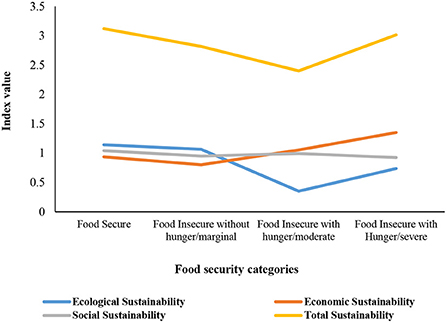
Figure 4. The status of ecological, economic, and social sustainability in different categories of food security.
The results of the Tobit model are reported in Table 8. Four Tobit models were estimated in which each dimension of sustainability was added as an independent factor. Sex of head of household, head's job, agricultural activity, monthly rent, number of rooms, personal saving, and receiving a loan from a bank were significantly and inversely associated with food insecurity. The number of female and male children within a household, home area, age of home, distance from the city center, and receiving governmental support had a significant and direct association with food insecurity. The results demonstrated that none of the sustainability dimensions had a significant association with food insecurity.
To be confident in validity of an insignificant association of sustainability dimensions with food insecurity, the scatter plots of all these dimensions were depicted (Figures 5–8). All plots revealed that these dimensions are located in a specified range, and therefore, a high distribution is not viewed. These dimensions were altered in a specific interval for all farmers. Thus, there is no significant difference among the farmers in terms of agricultural sustainability behavior.
Among these dimensions, the behavior of the farmers is very close to each other in terms of social dimension.
Discussion
The present study not only highlights the alarming rate of food insecurity for the households in this agricultural region, but also describes the association between food insecurity and sustainable agriculture among farmers and determines the associated factors. We recognized three hypotheses to organize the study.
H1- More than half of farmers are food insecure in the study location.
Assessment of household food security status showed that having and not having one or more children overshadows food security status. Food insecurity was more prevalent in households with one or more children than those without any children. Households who have at least a child have to allocate more income to prepare the needed foods for the members. Also, a part of the household's income should be paid for other costs instead of food consumption. This situation can affect food security. Some studies reported that having at least one child can affect a household's food security (33–37). About 28% of households who have at least one child faced very low food security, which shows the importance of the attention to these households in food aid programs by policymakers and governmental institutions (38, 39). About two-thirds of children of the participating households (about 67%) faced low and very low food security. The literature confirmed two groups, including women and children, have more vulnerability to food insecurity and should be supported by the related institutions (33, 40, 41).
H2- Most of the farmers are sustainable in the process of agricultural activity.
Of the total sample, 72.8% of the farmers were socially unsustainable. The check of participating households' responses showed that the knowledge of farmers about agricultural activities and cooperation of farmers with each other play a key role in controlling the social dimension of sustainable agriculture. The results revealed the low level of these dimensions in the study location. Some studies suggest that the low level of the social dimension of sustainability is the main reason for the low level of total sustainability (42–44). Despite the increasing recognition of the role of agriculture in the protection of the social heritage of territories, their traditions, and cultures, the assessment of the social dimension of sustainability has received less attention than the assessment of ecological and economic sustainability (14).
H3- Economic sustainability of farmers is positively associated with food security
The economic dimension of sustainable agriculture showed that the farmers cannot optimally allocate their financial resources to the cultivation process. The high level of service cost, input costs, and low level of efficiency can be introduced as the important reasons for 58% of the economic unsustainability of the participated farmers. The economic sustainability of agricultural activities is a fundamental restriction on the endurance of farm systems over time. In recent decades, this facet has become more vital, due to decreasing public support for agriculture and the intensification of global trade in agricultural productions. As a result, farmers face increasingly difficult decisions to improve the levels of competitiveness and profitability of traditional agricultural products (14).
About 67% of the total sample was ecologically unsustainable. The review of items of this dimension demonstrated that the high consumption of pesticide, insecticide, fertilizer, the inappropriate ways of cultivation, excessive water consumption, and land degradation are essential reasons for the low level of the ecological dimension of sustainable agriculture. Some scholars believe that ecological sustainability is the most important issue to provide healthier foods, and eventually, food security in a society (45). (46) contend that the ecological impacts on sustainable food consumption is inevitable, because it directly affects people's health (46).
H4- The sustainable agriculture is positively and significantly associated with food security
To find the answer to an important question of the present study, a Tobit model was estimated to figure out the association of sustainable agricultural dimensions with food security. The result showed that none of these dimensions were significantly associated with food security status in the study location. Although some scholars believe that there is a significant association between sustainable agriculture and food security in different regions in the world (4, 8, 47), and one can't exist without the other (10), this is strongly linked to the assessment period and the type of area. The results of the present study proved an insignificant association because most farmers were unsustainable and their behavior were close to each other. This similarity includes the economic, social, and ecological dimensions of sustainable agriculture. For this reason, a significant association between sustainability indicators (as independent factors) and food security status cannot be achieved. Also, as Nkomoki et al. (8) contended, the type of sustainability indicator can affect the results. The local farmers don't have a long-term vision and only want to catch instantaneous output without considering a sustainable production process.
Conclusion
In the present study, we followed an important puzzle of the association of agricultural sustainability with food security using a quantitative approach. First, although households who have one or more children were more likely to be food insecure than those without any child, the status of food insecurity was dangerously high in the study location. Financial supports in the form of food subsidies, direct income payment, and food baskets are necessary to increase food security. Second, government and stakeholder engagement in promoting sustainable management programs can play an important role in raising awareness of sustainable agriculture activity, because this knowledge is a seriously lacking in the study location. The low level of agricultural sustainability is due to the lack of macroeconomic policies in the region to promote and disseminate the principles of sustainability, lack of plans and actions to promote sustainability by stakeholders and policymakers, ignorance of the target community, being subsistence, and fall into the deprivation trap. We suggest that policy makers use two short-term and long-term strategies to improve the level of agricultural sustainability. Short term, the development of educational programs for farmers, implementation of extension instructions, identifying specific policies, encouraging environmentally friendly farming methods, and strategies in the line of sustainability can contribute the farmers for being on the path of agricultural sustainability. As the long-term policies, land consolidation, mechanization of farms, production and supply of sustainable inputs, including organic fertilizers and organic pesticides, modification of cultivation pattern for development of water-less crops, and formation of agricultural cooperatives are suggested. Third, the results support the fact that the assessment of agricultural sustainability at microeconomic level, short-term period, and a small specified location cannot lead to reliable results due to the close behavior of farmers in these areas. Therefore, it cannot be strongly inferred that there is always a significant association between agricultural sustainability and food security in all regions. The results of this study can support farmers and policymakers responsible for ensuring sustainable management of agricultural production while providing access to safe, healthy, and nutritious food for the growing population.
Data availability statement
The original contributions presented in the study are included in the article/supplementary material, further inquiries can be directed to the corresponding author/s.
Ethics statement
Ethical review and approval was not required for the study on human participants, in accordance with the local legislation and institutional requirements.
Author contributions
SS: validation, resource, and data mining. MP-C: supervision, formal analysis, methodology, and writing—original draft preparation. SG: writing—methodological advice, interpretation, and reviewing and editing. MR: conceptualization, software, and writing—reviewing and editing. All authors contributed to the article and approved the submitted version.
Conflict of interest
The authors declare that the research was conducted in the absence of any commercial or financial relationships that could be construed as a potential conflict of interest.
Publisher's note
All claims expressed in this article are solely those of the authors and do not necessarily represent those of their affiliated organizations, or those of the publisher, the editors and the reviewers. Any product that may be evaluated in this article, or claim that may be made by its manufacturer, is not guaranteed or endorsed by the publisher.
References
1. United Nations. How Certain Are the United Nations Global Population Projections? New York, NY (2019).
2. Pakravan-Charvadeh MR, Mohammadi-Nasrabadi F, Gholamrezai S, Vatanparast H, Flora C, Nabavi-Pelesaraei A. The short-term effects of COVID-19 outbreak on dietary diversity and food security status of Iranian households (A case study in Tehran province). J Clean Prod. (2020) 281:124537. doi: 10.1016/j.jclepro.2020.124537
3. Chowdhury RB, Moore GA, Weatherley AJ, Arora M. Key sustainability challenges for the global phosphorus resource, their implications for global food security, and options for mitigation. J Clean Prod. (2017) 140:945–63. doi: 10.1016/j.jclepro.2016.07.012
4. Skaf L, Buonocore E, Dumontet S, Capone R, Franzese PP. Food security and sustainable agriculture in Lebanon: an environmental accounting framework. J Clean Prod. (2019) 209:1025–32. doi: 10.1016/j.jclepro.2018.10.301
5. Pakravan-Charvadeh MR, Flora C, Khan HA. simulating potential associated socio-economic determinants with sustainable food security (a macro-micro spatial quantitative model). Front Nutr. (2022) 10:1–11. doi: 10.3389/fpubh.2022.923705
6. Borsato E, Tarolli P, Marinello F. Sustainable patterns of main agricultural products combining different footprint parameters. J Clean Prod. (2018) 179:357–67. doi: 10.1016/j.jclepro.2018.01.044
7. Janker J, Mann S. The social dimension of sustainability in agriculture. A review of sustainability assessment tools. Environ. Dev. Sustain. 22:1471–1691 (2018). doi: 10.1007/s10668-018-0282-0
8. Nkomoki W, Bavorová M, Banout J. Adoption of sustainable agricultural practices and food security threats: Effects of land tenure in Zambia. Land Use Policy. (2018) 78:532–8. doi: 10.1016/j.landusepol.2018.07.021
9. Pakravan-Charvadeh MR, Khan HA, Flora C. Spatial analysis of food security in Iran: associated factors and governmental support policies. J Public Health Policy. (2020) 532–538. doi: 10.1057/s41271-020-00221-6
10. Berry EM, Dernini S, Burlingame B, Meybeck A, Conforti P. Food security and sustainability: can one exist without the other? Public Health Nutr. (2015) 18:2293–302. doi: 10.1017/S136898001500021X
11. Pakravan-Charvadeh MR, Flora CB, Emrouznejad A. Impact of socio-economic factors on nutrition 1 efficiency: an application of data envelopment analysis. Front Nutr. (2022) 0:526. doi: 10.3389/fnut.2022.859789
12. El Bilali H, Callenius C, Strassner C, Probst L. Food and nutrition security and sustainability transitions in food systems. Food Energy Secur. (2019) 8:1–20. doi: 10.1002/fes3.154
13. Capone R, El Bilali H, Debs P, Cardone G, Driouech N, Bilali H, et al. Food system sustainability and food security: connecting the dots. J Food Secur. (2014) 2:13–22.
14. Gaviglio A, Bertocchi M, Demartini E. A tool for the sustainability assessment of farms: selection, adaptation and use of indicators for an Italian case study. Resources. (2017) 6:13–22. doi: 10.3390/resources6040060
15. Lang T, Barling D. Food security and food sustainability: reformulating the debate. Geogr J. (2012) 178:313–26. doi: 10.1111/j.1475-4959.2012.00480.x
16. Menozzi D, Fioravanzi M, Donati M. Farmer's motivation to adopt sustainable agricultural practices. Biobased Appl Econ. (2015) 4:125–47.
17. Michalk DL, Kemp DR, Badgery WB, Wu J, Zhang Y, Thomassin PJ. Sustainability and future food security—A global perspective for livestock production. Land Degrad Dev. (2019) 30:561–73. doi: 10.1002/ldr.3217
18. Rodrigues GS, Rodrigues IA, Buschinelli CC, de Barros I. Integrated farm sustainability assessment for the environmental management of rural activities. Environ Impact Assess Rev. (2010) 30:229–39. doi: 10.1016/j.eiar.2009.10.002
19. Wustenberghs H, Coteur I, Debruyne L, Marchand F. Survey of Sustainability Assessment Methods. (2015). p. 1–86.
20. Li T, Zhang H, Yuan C, Liu Z, Fan C. A PCA-based method for construction of composite sustainability indicators. Int J Life Cycle Assess. (2012) 17:593–603. doi: 10.1007/s11367-012-0394-y
21. Pakravan-Charvadeh MR, Savari M, Khan HA, Gholamrezai S, Flora C. Determinants of household vulnerability to food insecurity during COVID-19 lockdown in a mid-term period in Iran. Public Health Nutr. (2021) 1:1–10. doi: 10.1017/S1368980021000318
22. Soler-Rovira J, Soler-Rovira P. Assessment of Aggregated Indicators of Sustainability Using PCA: The Case of Apple Trade in Spain (2008).
23. Martín JC, Mendoza C, Román C. A DEA travel–tourism competitiveness index. Soc Indic Res. (2015) 130:937–57. doi: 10.1007/s11205-015-1211-3
24. Marques ES, Reichenheim ME, De Moraes CL, Antunes MML, Salles-Costa R. Household food insecurity: a systematic review of the measuring instruments used in epidemiological studies. Public Health Nutr. (2015) 18:937–957. doi: 10.1017/S1368980014001050
25. McKay FH, Haines BC, Dunn M. Measuring and understanding food insecurity in Australia: a systematic review. Int J Environ Res Public Health. (2019) 16:476. doi: 10.3390/ijerph16030476
26. Pakravan-Charvadeh MR, Flora C. Sustainable food consumption pattern with emphasis on socioeconomic factors to reduce food waste. Int. J. Environ. Sci. Technol. (2022) 476–503. doi: 10.1007/s13762-022-04186-9
27. Albertini F, Gomes LP, Grondona AEB, Caetano MO. Assessment of environmental performance in building construction sites: data envelopment analysis and Tobit model approach. J Build Eng. (2021) 44:102994. doi: 10.1016/j.jobe.2021.102994
28. Dalei NN, Joshi JM. Estimating technical efficiency of petroleum refineries using DEA and tobit model: an India perspective. Comput Chem Eng. (2020) 142:107047. doi: 10.1016/j.compchemeng.2020.107047
29. Álvares L, Amaral TF. Food insecurity and associated factors in the Portuguese population. Food Nutr Bull. (2014) 35:S395–402. doi: 10.1177/156482651403500401
30. Behzadifar M, Behzadifar M, Abdi S, Arab Salmani M, Ghoreishinia G, Falahi E. Prevalence of food insecurity in Iran: a systematic review and meta-analysis. Arch Iran Med. (2016) 19:288–94. doi: 10.1177/15648265140350040
31. Bulawayo M, Ndulo M, Sichone J. Socioeconomic determinants of food insecurity among zambian households: evidence from a national household survey. J Asian Afr Stud. (2019) 19:288–294. doi: 10.1177/0021909619841655
32. Kharisma V, Abe N. food insecurity and associated socioeconomic factors: application of rasch and binary logistic models with household survey data in three megacities in Indonesia. Soc Indic Res. (2020) 148:655–79. doi: 10.1007/s11205-019-02210-z
33. Pakravan-Charvadeh MR, Vatanparast H, Khakpour M, Flora C. Food insecurity status of afghan refugees is linked to socioeconomic and resettlement status, gender disparities and children's health outcomes in Iran. Child Indic Res. (2021) 14:1–22. doi: 10.1007/s12187-021-09827-y
34. Pakravan-Charvadeh MR, Mohammadi-Nasrabadi F. The association between social welfare, food security and diet diversity among Afghan immigrant households in the Southern Areas of Tehran Province. Iran J Nutr Sci Food Technol. (2020) 15:11–24.
35. Grace K, Frederick L, Brown ME, Boukerrou L, Lloyd B. Investigating important interactions between water and food security for child health in Burkina Faso. Popul Environ. (2017) 39:26–46. doi: 10.1007/s11111-017-0270-6
36. King C. Food insecurity and child behavior problems in fragile families. Econ Hum Biol. (2018) 28. doi: 10.1016/j.ehb.2017.11.002
37. Ralston K, Treen K, Coleman-Jensen A, Guthrie J (2018). Children's Food Security and USDA Child Nutrition Programs. United States Dep. Agric. Available online at: https://www.ers.usda.gov/publications/pub-details/?pubid=84002 (accessed November 11, 2022).
38. El-Sughayyar RH, Ghattas R, Hrimat N, Isaac J. Food security and health assessment of vulnerable households in the occupied Palestinian territory: a cross-sectional study. Lancet. (2013) 382:S10. doi: 10.1016/S0140-6736(13)62582-9
39. Martorano B, Metzger L, Sanfilippo M. Chinese development assistance and household welfare in Sub-Saharan Africa. World Dev. (2020) 129:1–21. doi: 10.1016/j.worlddev.2020.104909
40. Hanson KL, Sobal J, Frongillo EA. Gender and marital status clarify associations between food insecurity and body weight. J Nutr. (2007) 137:1460–5. doi: 10.1093/jn/137.6.1460
41. Hernandez DC, Reesor L, Murillo R. Gender disparities in the food insecurity–overweight and food insecurity–obesity paradox among low-income older adults. J Acad Nutr Diet. (2017) 117:1087–96. doi: 10.1016/j.jand.2017.01.014
42. Feitelson E, Chenoweth J. Water poverty: towards a meaningful indicator. Water Policy. (2002) 4:263–81. doi: 10.1016/S1366-7017(02)00029-6
43. Schindler J, Graef F, König HJ, Mchau D, Saidia P, Sieber S. Sustainability impact assessment to improve food security of smallholders in Tanzania. Environ Impact Assess Rev. (2016) 60:52–63. doi: 10.1016/j.eiar.2016.04.006
44. Shao J, Taisch M, Mier MO. Influencing factors to facilitate sustainable consumption: from the experts' viewpoints. J Clean Prod. (2017) 142:203–16. doi: 10.1016/j.jclepro.2015.12.111
45. Schmitt E, Galli F, Menozzi D, Maye D, Touzard JM, Marescotti A, et al. Comparing the sustainability of local and global food products in Europe. J Clean Prod. (2017) 165:346–59. doi: 10.1016/j.jclepro.2017.07.039
46. Jaeger-Erben M, Rückert-John J, Schäfer M. Sustainable consumption through social innovation: a typology of innovations for sustainable consumption practices. J Clean Prod. (2015) 108:784–98. doi: 10.1016/j.jclepro.2015.07.042
Keywords: sustainable agriculture, food security, socio-economic factors, Iran, nutrition
Citation: Sahraei S, Pakravan-Charvadeh MR, Gholamrezai S and Rahimian M (2022) Assessing the association of sustainable agriculture with rural household food security (considering ecological, economic, and social aspects). Front. Nutr. 9:899427. doi: 10.3389/fnut.2022.899427
Received: 18 March 2022; Accepted: 03 October 2022;
Published: 20 October 2022.
Edited by:
Pouria Ataei, Tarbiat Modares University, IranReviewed by:
Rahim Alhamzawi, University of Al-Qadisiyah, IraqAziz Khan Khan, Guangxi University, China
Copyright © 2022 Sahraei, Pakravan-Charvadeh, Gholamrezai and Rahimian. This is an open-access article distributed under the terms of the Creative Commons Attribution License (CC BY). The use, distribution or reproduction in other forums is permitted, provided the original author(s) and the copyright owner(s) are credited and that the original publication in this journal is cited, in accordance with accepted academic practice. No use, distribution or reproduction is permitted which does not comply with these terms.
*Correspondence: Mohammad Reza Pakravan-Charvadeh, cGFrcmF2YW4ubUBsdS5hYy5pcg==
 Salman Sahraei
Salman Sahraei Mohammad Reza Pakravan-Charvadeh
Mohammad Reza Pakravan-Charvadeh Saeed Gholamrezai
Saeed Gholamrezai Mehdi Rahimian
Mehdi Rahimian